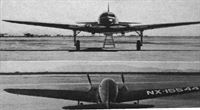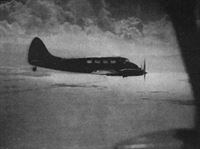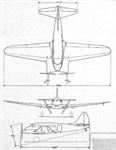
Описание
Страна : США
Год : 1937
Единственный экземпляр
Twin-engined six-passenger light commercial monoplane
Flight, May 1938
A "FLAT" ENGINED TRANSPORT
The Alcor Junior : Unusual Motor Arrangement and Composite Construction
THE latest Alcor C-6-1, designed by Alan H. Lockheed, is an entirely new model, although as far back as 1930-31 the same designer had produced a machine based on the Lockheed Vega with a substantially similar and unorthodox type of engine installation. In 1934 the first high-wing Alcor appeared and this, too, had the same "prone" twin-engined arrangement.
The construction of the new Alcor Junior Transport, as it is termed, is composite. Laminated spruce, steel tubing and alloy sheet are each used where it can have a definite advantage. The spruce is used for control surfaces and in the outer wing sections, while chrome-molybdenum steel tubing is employed at the points of heavy local stresses such as landing gear attachment, engine mounting and at the wing roots. The wing, which is fully cantilever, has two spars and is covered with a three-ply skin except around the fuel tanks, where sheet Duralumin is attached by screws as a protection and to facilitate inspection.
Hydraulically operated trailing-edge flaps are provided and the ailerons are of Frisc type with ball bearings. The undercarriage is, of course, retractable, and turns aft through a 90 deg. arc into wheel wells in the underside of the wing.
In the semi-monocoque fuselage the nose portion and pilot’s cockpit are made up of steel tubing covered with alloy sheet, which is easily detachable. The main section is a two-ply shell of Alcor manufacture moulded under pressure, the longerons and formers being of spruce. The tail surfaces are fully cantilever and similar in construction to the control surfaces. The whole of the machine is covered with lightweight fabric and lacquered to give an aerodynamically efficient finish.
The cabin can be arranged to carry four or six passengers, and full dual control is provided for the crew of two.
The unorthodox engine installation is designed to give minimum. head resistance and to secure high efficiency on one engine in case of a motor failure. Two 250 h.p. supercharged Menasco C6S-4 inverted, in-line, air-cooled, six-cylinder engines are mounted on their sides, cylinder banks inboard. Cowlings and air-cooling scoops are faired into the front structure of the fuselage as well as into the wing, top and bottom.
The main engine mountings are secured to the front wing spar, and extensions of the steel tube cradles pass back to the rear spar. Cantilever torque arms restrain each engine af approximately its mid-point.
Constant-speed Hamilton Standard airscrews are used, with Arens controls. The tip clearance between the two airscrews is only twelve inches and their thrust line, in reference to the centre line of the machine, is toed out 4 deg.
Behind the cabin are the toilet and baggage compartments. The radio equipment is also carried, entirely enclosed, in the rear section of the fuselage.
The single-engine performance of the Alcor is said to be quite exceptional, and the particular type of engine mounting makes it possible to fly the machine "hands off" on one motor. The performance in these circumstances includes a ceiling of 12,000ft., climb of 300ft./min. and speed of 174 m.p.h.
The track of the Alcor is wide for the machine (13ft. 2 1/2 in.) and the general ground handling is said to he very good.
ALCOR C-6-1 TRANSPORT.
(Two 250 h.p. Menasco C6S-4).
Empty Weight - 4,141 lb.
Gross Weight - 6,200 lb.
Wing Area - 318 sq. ft.
Wing Loading - 19.5 Ib./sq. ft
Power Loading - 12.2 lb. sq. ft.
Range - 675/835 miles.
Max. sea level speed - 190 m.p.h. at 2,300 r.p.m., 240 h.p.
Max. speed at 5,500 ft. - 211 m.p.h. at 2,300 r.p.m., 250 h.p.
Cruising speed at 5,500 ft. - 191 m.p.h. at 2,000 r.p.m., 187 h.p.
Cruising Consumptions: fuel - 37 gal./hr., oil=1.25 qt./hr.
Cruising speed at 10,000 ft. - 200 m.p.h. at 2,000 r.p.m., 187 h.p.
Max. sea level climb m 1,350 ft./min.
Ceiling = 20,000 ft.
- Flight, May 1938
A "FLAT" ENGINED TRANSPORT
Фотографии
-
Jane's All the World Aircraft 1938 / 03 - All the world's aeroplanes
Регистрационный номер: NX15544 [3] The Alcor C-6-1 Six-passenger Light Commercial Monoplane (two 250 h.p. Menasco C-6-S engines).
-
Flight 1938-05 / Flight
Регистрационный номер: NX15544 [3] -
Flight 1938-05 / Flight
Регистрационный номер: NX15544 [3] In a side view the Alcor C-6-1 does not appear to be unusual, although the forward position of the two airscrews is apparent. The Alcor Junior Transport seats eight.
- Фотографии



